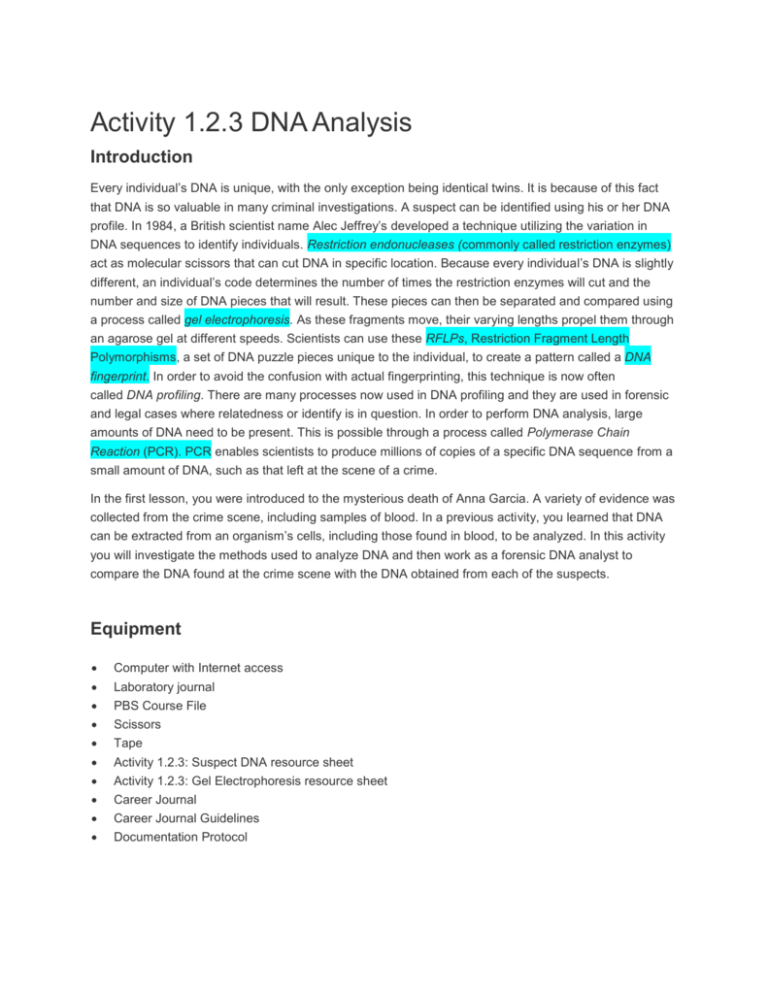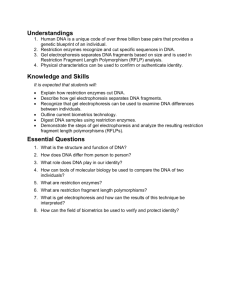Activity 1.2.3 DNA Analysis
advertisement

Activity 1.2.3 DNA Analysis Introduction Every individual’s DNA is unique, with the only exception being identical twins. It is because of this fact that DNA is so valuable in many criminal investigations. A suspect can be identified using his or her DNA profile. In 1984, a British scientist name Alec Jeffrey’s developed a technique utilizing the variation in DNA sequences to identify individuals. Restriction endonucleases (commonly called restriction enzymes) act as molecular scissors that can cut DNA in specific location. Because every individual’s DNA is slightly different, an individual’s code determines the number of times the restriction enzymes will cut and the number and size of DNA pieces that will result. These pieces can then be separated and compared using a process called gel electrophoresis. As these fragments move, their varying lengths propel them through an agarose gel at different speeds. Scientists can use these RFLPs, Restriction Fragment Length Polymorphisms, a set of DNA puzzle pieces unique to the individual, to create a pattern called a DNA fingerprint. In order to avoid the confusion with actual fingerprinting, this technique is now often called DNA profiling. There are many processes now used in DNA profiling and they are used in forensic and legal cases where relatedness or identify is in question. In order to perform DNA analysis, large amounts of DNA need to be present. This is possible through a process called Polymerase Chain Reaction (PCR). PCR enables scientists to produce millions of copies of a specific DNA sequence from a small amount of DNA, such as that left at the scene of a crime. In the first lesson, you were introduced to the mysterious death of Anna Garcia. A variety of evidence was collected from the crime scene, including samples of blood. In a previous activity, you learned that DNA can be extracted from an organism’s cells, including those found in blood, to be analyzed. In this activity you will investigate the methods used to analyze DNA and then work as a forensic DNA analyst to compare the DNA found at the crime scene with the DNA obtained from each of the suspects. Equipment Computer with Internet access Laboratory journal PBS Course File Scissors Tape Activity 1.2.3: Suspect DNA resource sheet Activity 1.2.3: Gel Electrophoresis resource sheet Career Journal Career Journal Guidelines Documentation Protocol Procedure Part I: Restriction Enzymes Restriction enzymes cut DNA at specific nucleotide sequences. The recognition sequence is often four to six nucleotides long. Many different restriction enzymes are produced naturally by bacteria. These enzymes are used by bacteria as a defense against invading organisms, such as viruses, because they can cut up the invading organism’s DNA before it has time to take control of the cell. Different restriction enzymes recognize and cut different DNA sequences. For example, the restriction enzyme HaeIII cuts between the base pairs GG │ CC. 1. Draw a line in the following sequence of DNA where the restriction enzyme HaeIII would cut. Note how many fragments were created. 2. Show your locations to your teacher and compare them to the answer. 3. Obtain a pair of scissors and Activity 1.2.3 Suspect DNA sheet from your teacher. 4. Write the initials of each suspect on the back of each sequence to ensure that DNA sequences from different suspects do not get mixed up. 5. Use your scissors (which represent the HaeIII restriction enzyme) to cut one of the DNA samples. Only cut your DNA samples when you see the pattern GGCC. Cut between the G and C. 6. Count the number of base pairs (bp) in each DNA fragment that you have created. A base pair consists of two complementary bases. Record the number of base pairs in each fragment on the back side of each DNA piece. 7. Repeat steps 5 and 6 with the DNA samples from each of the remaining suspects. Part II: Gel Electrophoresis After being cut by restriction enzymes, DNA fragments remain mixed in solution and are undistinguishable from one another. The fragments need to be separated in order to be compared. This can be done by passing the fragments through an agarose gel. The gel acts like a screen. Small pieces of DNA move through the gel more easily than the large pieces, so the small pieces travel further through the gel than the large pieces. Since DNA has a negative charge, you can separate the DNA fragments by applying an electric current to the gel. This means that the DNA will migrate toward the positive pole when it is placed in an electric field. Remember, opposites attract. 8. Review the process of gel electrophoresis by viewing the animation listed below. This animation will give you an overview of the entire process using gel electrophoresis to separate DNA segments. Take notes below o Genetic Science Learning Center – Gel Electrophoresis Virtual Lab http://learn.genetics.utah.edu/content/labs/gel/ (Links to an external site.) (Links to an external site.) Notes: 9. Obtain an Activity 1.2.3 Gel Electrophoresis sheet from your teacher (Resources). 10. Fold each DNA sequence for each suspect accordion-style and tape them on the gel electrophoresis diagram according to the number of base pairs. Be sure to put your samples in the proper columns. Remember, DNA migrates away from the negative electrode toward the positive electrode when placed in an electric field. Note where the negative and positive electrodes are located. Alternatively, you may be asked to tape your DNA fragments to a wall-size gel, whiteboard, or blackboard. 11. Use your paper gel as your guide and draw in the bands you would see in each lane of the gel below. NOTE: Complete this step ONLY if you taped or drew your bands on a wall gel and not on the gel electrophoresis diagram. 12. Add all new findings about the case to your Uni t 1 - Investigative Notes Resource Sheet (OneNote). Adjust your theories as needed. 13. Follow the Career Journal Guidelines and complete an entry in your Career Journal for a forensic DNA analyst. 14. Answer the Conclusion questions. Conclusion 1. Whose DNA was found at the crime scene? Explain how you came to your conclusion. It was Anna Garcia’s DNA found at the scene. 2. Explain the role that restriction enzymes and gel electrophoresis play in DNA profiling. The role for both of these things is to separate different parts of DNA 3. What would happen if the gel was placed with the DNA starting closest to the positive electrode? You wouldn't see its variant-length restriction-enzyme-sliced groups spreading out in bands. You would just see a large, stained clump of what you inserted into the DNA...and it would be right under or at the positive electrode. 4. Besides DNA profiling, for what other reasons might scientists and researchers use DNA analysis? Explain your reasoning. Another reason why scientist would use DNA analysis would be to look at peoples DNA and see if there is anything wrong with their DNA or even if there are ways to lead a criminal to their crime. 5. Describe how the biomedical science professional introduced in this activity would assist with Anna’s case. Because they would be able to determine what DNA is left at the scene, if they are related to the crime, or even who did the crime.







